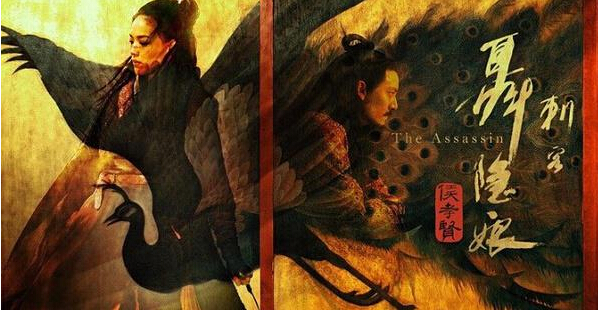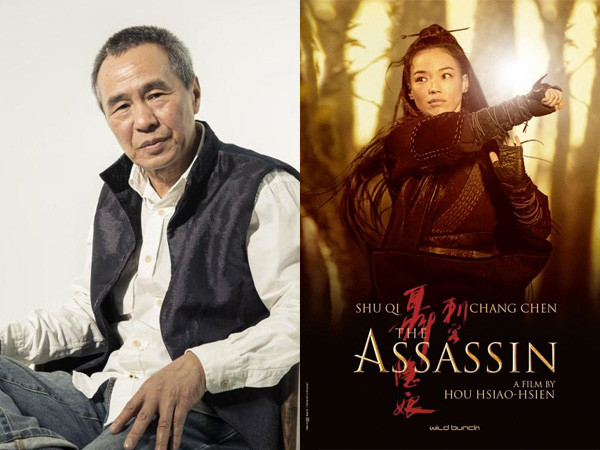The midday sun beats down unforgivingly. It’s noon by the way the shadow eats away at the two horses, swallowing them whole and making them appear gaunt and two-legged. The harsh light bleaches the world into blinding whiteness: only two colors remain, white and black. The starkness mirrors the two women who now appeared onscreen, one is wearing white and the other black. The woman in white hands the woman in black a dagger and instructs her to kill a man.
Cut to a team of riders. The woman in black watches the leader silently through the trees. Then, without warning, she runs out and in one swift motion slits his throat. No blood spills onscreen, but seconds later, the man topples off his horse.
This is “The Assassin” (《刺客聶隱娘》.

“The Assassin” (2015) is a film about a young woman who confronts the question “To be or not to be.” Should she fulfill her fate as an assassin and kill her cousin/childhood love? (image credit: “The Assassin”/Web)
“The Assassin,” which won the 2015 Cannes Film Festival “Best Director” Award, is the long-awaited film from Taiwanese director Hou Hsiao-Hsien following Hou’s 2007 collaboration with French actress Juliette Binoche in remaking “Le Voyage Du Ballon Rouge” (“The Flight of the Red Balloon”).
The story takes place in 9th century China of Tang Dynasty and revolves around Nie Yinniang (聶隱娘/played by Taiwanese actress Shu Qi). Yinniang is the daughter of a general. Taken away at a tender age, she was raised as an assassin. Now, having grown and perfected the art of combat, she was returned to her birthplace with the assignment to kill the governor, Tian Ji’an (played by Taiwanese actor Chang Chen) who was once her betrothed.
But in opposition to what is expected with a film where the protagonist is a kick-ass swordswoman — elaborate fight scenes, kick-ass martial art moves, “The Assassin” is predominantly silent and static. The finished product is Hou’s contrarian interpretation of the film genre wuxia (武俠).

Yinniang, shown through layered fabric, is both the observer and the observed (veiled). (image credit: Web/”The Assassin”)
The genre consists of two components: the wu (武), which encompasses martial arts/military/war, and the xia (俠), which describes the type of protagonist found in a wuxia film or literature. According to the famed Han Dynasty historian Sima Qian, a xia is defined as one who is honest in words, effective in action, faithful in keeping promises, fearless in offering his [or her] own life to free the righteous from bondage.
A xia is typified by his or her unparalleled swordsmanship, adhering to the principles of loyalty, reciprocity, and duty, according to Once Upon a Time in China. And because of his or her superior killing skills and high moral, a xia makes a perfect assassin. But not Hou’s Yinniang. While equipped with marvelous capability to kill, she faults with having compassion. In the film, Yinniang refrains from killing a man because her target was sleeping with his child.
On top of having a protagonist who fails to rise to the archetypal xia, the film deviates from standard wuxia film genre by keeping physical combats, epic battle scenes as well as elaborate kung-fu stunts to a minimum. Instead, Hou spotlights Yinniang’s quandary defining her humanity. Will Yinniang walk down the solitary path of an assassin, severing all emotional ties including those romantic and familial? Or will she embark on an alternative path, and if yes, what that will be?
In an interview (see original quote below), Hou remarks that the women in his films do not attain love easily, his assassin do not fight carelessly, and his wuxia characters do not kill nonchalantly. He added that regardless of cultural divergence (West/East), time period, literature or film genre, every assassin seeks self awakening.
我的女人不輕易得其所愛,我的刺客不隨便打架,我的武俠不殺人。不分東西、不論年代、不計文學或電影,縱古至今,每位刺客(特務)都是追求「自我意識覺醒」的性情中人;也許是叛離體制,也許是認清自身的孤獨,也許浪漫一點,放棄人倫之情。

Director Hou Hsiao Hsien (image on left) rolls out “The Assassin,” his interpretation of film genre wuxia. (image credit: Web/ETToday)
Indeed, to be an assassin — having chosen the path “kill to live, live to kill,” equates absolute solitude. Take Yinniang for example, she can never be like the other women of her time: marry, have children and raise a family. As a social anomaly, she is very much like the blue bird, or 青鸞 (peacock/ pronounced Qing Luan) that was first mentioned at the beginning of and later repeatedly alluded to throughout the film.
A Qing Luan that was captured and gifted to the King refused to sing for three years. The Queen suggested putting a mirror in front of the bird, for she has heard that birds sing only to their own kind. Therefore a mirror was placed in front of the bird. And that night, the bird sang and danced to its image reflected in the mirror. The next day, it deceased.
Yinniang is the bird, alone and companionless. And perhaps Hou’s conscious decision to highlight that aspect of a xia is what drives the divergent reviews. The slow moving wuxia film stands as a visual masterpiece (just look at the deliberate slowness Hou allows Yinniang’s character to reveal herself at the palace — a still camera capturing the barely perceptible movements of the curtain as well as the light/shadow casted by the wavering candles), yet, on the other hand, the film revolves around a plot that is difficult and confusing. The opaqueness is a shame. In fact, critics could argue that Hou’s indulgence in representing his artistic vision a failure.
The film, which consists of great intelligence and aesthetic refinement, no doubt has a lot to convey to the audience. Indeed, the heavy quietude and seriousness of the film address the questions of what it means to belong to the wuxia film genre as well as the moral weight of taking a human life. But how successful is the effort if the message is lost to the general audience?
I confess, my engagement faltered halfway into the film because I was having such a hard time figuring out what’s going on with the plot. Nonetheless, I highly recommend taking a moment to delve into “The Assassin.” If not for the story, then for the film’s sheer beauty.
